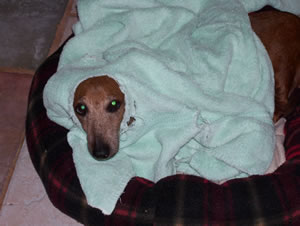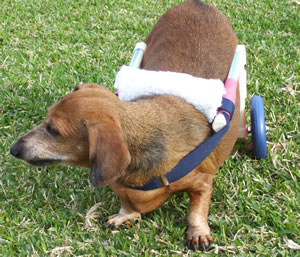IVDD is a congenital disease (present at birth). Not all dogs in the higher risk breeds will have it, but for those who do, it will last their entire lifetime. It is most common in chondrodystrophic breeds such as Dachshunds (most common breed to carry disease), Shih Tzus, Lhasa Apsos, Pugs, Boston Terriers, Yorkies, Poodle, Bassets, Corgis and basically any breed OR mixture of that breed that has been miniaturized and/or shows signs of dwarfism. (Short, crooked limbs and long bodies.)
IVDD is virtually un-diagnosible until a rupture or bulging disc occurs. Many dogs with IVDD show no signs of a problem their entire lives, but many more either rupture a disc during their lives or have episodes of bulging discs. (These IVDD dogs can also rupture discs in their necks (cervical discs) but this discussion covers only thoracic/lumbar discs in the dogs back. So, please be aware of this possibility also.)
The frequency of IVDD in certain breeds (especially Dachshunds), makes it even more important if one owns such a breed, to be ever vigilant to the warning signs of an impending problem and do one’s best to keep that dog from doing any movements which tend to aggrevate the situation. (Jumping up and down off of furniture and beds, taking large steps up or down, any twisting motion of the spinal column such as jumping to catch a frisbee). All of these activities should be kept to a minimum, especially as these dogs age (without keeping the dog in a padded room!)
Warning signs of an impending rupture can include: reluctance to go up or down a step, reluctance to move at all, loss of appetite, wanting to hide under a bed or under a cover, yelping when picked up or when using the bathroom, limping on one or both rear legs, (front legs with a cervical disc), shivering, panting or just generally “not feeling well” or being off. Being aware of a change in attitude or habit with your own dog will help you recognize the situation before it happens.
If your dog shows any signs of discomfort as described above, immediately confine them to a small crate, pen or bed until you can get them to your veterinarian for a physical exam. It is never wrong to be over vigilant with a dog who may have IVDD.
When a dog has IVDD, the discs that lie between each vertebrae in the spinal column become prematurely brittle and prone to rupture. This also happens in every living thing with a spinal column as we age, but in an IVDD dog, this can happen as early as one year of age. With the most common occurances of rupture between the ages of 5 and 10.
The disc is made up of two components, the inner, “cushiony” center, or NUCLEUS PULPOSUS and the outer ring called the ANNULUS FIBROSUS. In a normal intervertebral disc, this center or Nucleus is very soft and jelly-like and the outer ring or Annulus is very spongy and flexible. These are the little shock absorbers that make a spine so flexible and protect it from trauma.
In a dog with IVDD, the inner Nucleus becomes hardened and resembles cottage cheese. The outer Annulus becomes brittle and begins to show cracks, especially near the top of the annulus, which lies directly under the spinal cord. This premature aging process causes the Annulus to become weakened, allowing the center Nucleus material to begin oozing out and upwards toward the spinal cord.
In the beginning stages, this may produce what is called a HANSON TYPE II DISC, or the classic “bulging disc”. The Annulus is still intact, but Nuclear material is pressing on the outer ring at its weakest point and causing pressure against the spinal cord. This is a painful situation and dogs with bulging discs often show signs of pain when picked up or at other times. They often acquire a hunched back appearance or hold their heads up as if looking at the sky.
Both of these behaviors are attempts to take pressure off of the area of bulging to alleviate the pain associated with it.
A HANSON TYPE I DISC is the true “ruptured disc”. It can come on suddenly, apparently without any warning and can result in impaired motor function, a wobbly gait or most often, complete loss of function in the hind limbs.
When a disc ruptures, it sets off a response from the body to send all available resources to the site of the trauma to the cord. This can send a pet into shock. That is a normal reaction of the body. So, many pets may seem disoriented or “depressed” immediately following a rupture and this may last for several days after the event.
The inflammation at the rupture site causes blood flow to be diminished to areas around and into the spinal cord. This is the major reason for the paralysis, damage to the spinal cord and the nerve roots that come out of it. These nerve roots are responsible for innervation of the rear limbs as well as the bladder and other parts of the “gut”. So, losing bladder function and/or bowel function are not uncommon with a disc rupture.
The spinal cord becomes bruised from the impact of the disc material and it begins healing as soon as the inflammation has subsided. It is normal not to see much change in function for the first few weeks to first month after a rupture, especially in dogs who do not have surgery.
When a dog “goes down” or becomes immobile in the rear legs, this is an emergency situation and you should immediately contact your veterinarian or emergency clinic! Get your pet immobilized and confined to a crate or kennel until you can get to the veterinarian for an exam.
It is imperative that action be taken as soon as this happens to give your pet a better chance of recovery. There is a small window of opportunity to help make the odds in your pet’s favor once this happens. It is in the first 12-24 hours. So, don’t hesitate to call your vet!
When a pet becomes paralyzed or has significant loss of rear limb function, there are two roads to travel. (I don’t consider euthanasia a good option unless the pet is in pain that cannot be controlled with drugs. That is a very rare scenario with this disease.)
Conservative treatment may be recommended by your vet after a thorough neurological exam. This can be very effective if a dog shows good neurological signs during that exam. Most commonly, dogs are put on either a steroid or NSAID to quickly relieve inflammation from around the spinal cord set up by the rupture, often times a pain reliever and/or a muscle relaxer are also given to help your pet recover from the shock of the rupture. After a few hours the rupture site is no longer painful to your pet. The area becomes numb due to nerve trauma. So, pain relievers may not be needed at all. That is always up to a veterinarian’s discretion.
Surgery may be an option for your pet also. Given the severity of the neurological signs at exam, surgery may be suggested. In pets who show greater signs of trauma, surgery will often be recommended in order to achieve a satisfactory recovery. Again, time is of the essence when deciding on surgery. A pet who has been “down” for more than 24 hours runs a risk of a lesser outcome from surgery than a pet who goes immediately to surgery following a rupture.
If surgery is not an option, either due to length of time a pet has been down, or financial worries, conservative therapy is always an option.
A dog who has had a rupture is technically not in any pain. These dogs just need help with nursing care and mobility. Time heals and many dogs who do not have surgery heal and return to full function. It may take many months for them to walk again, and during that recovery period, good nursing care and a good program of physical therapy are required.
NOTE: dog breeds not prone to IVDD can also rupture discs. This is usually caused by a traumatic even such as being hit by a car or a sharp impact to the spinal cord. These pets must also be seen immediately following such an even in which the rear legs are paralyzed or have diminished function in order to control further damage to the spinal cord which may impede recovery.
This is only a brief description of IVDD. If you have questions about your pet, please feel free to ask me. I can give you further details about surgery or conservative treatment as well as rehab.
Laurie



Pingback: Homepage